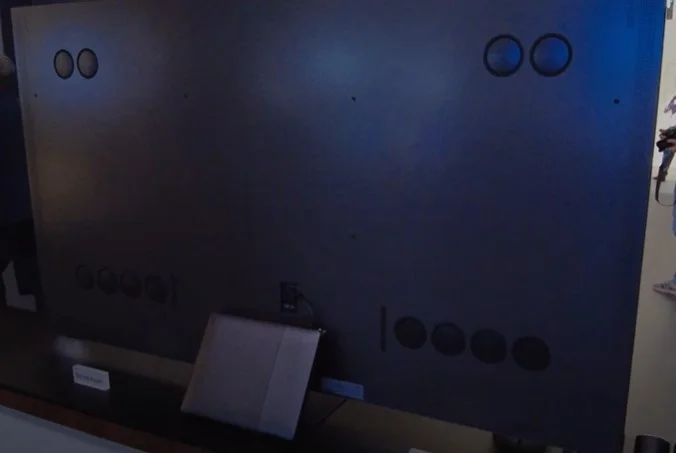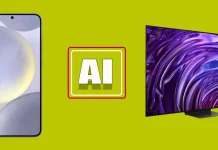Samsung introduced a 98-inch TV model. I decided to find out what makes this TV model different. Unfortunately, I couldn’t understand its features well and why Samsung is asking $39,999 for it. I will make a comparison and do a brief review of the new QN100B TV.
The cost of the Samsung QN100B TV
The first thing that catches my eye is the $40,000 price tag for a 98-inch TV with the whole model number 98QN100B.
Now for the price, I looked up the prices of similar Samsung TVs, and here’s the cost of other TV models, the cost of TVs I found on Samsung’s website.
- 98QN90A – $12999; this is the 2021 model.
- 98QN85B – $12999
- 98QN90B – $12999
- 98QN95B – $12999
- 85QN95B – $2799.
Thus, the QN100B costs $408 per inch,
The 98-inch TV of the younger series costs $132 per inch.
The 85-inch TV costs $33 per inch.
Why is there such a big difference in the cost of screens? You should know that 80% of the cost of a TV is the cost of the screen; several factors contribute to the price of a TV.
Production cost – how many screens can be made in one casting process; the larger the screen, the more time it takes to make many displays.
Scrap rate – the percentage of rejects in producing such large panels, especially when new technologies are introduced, can reach relatively high values.
The cost of the display depends on production conditions and how many panels can be made in one process; a 98″ screen is expensive. Of course, the cost of defective panels is also built into the price of good panels that are sent to make televisions.
It is hard to say what causes such a high price for the TV, but I can only give my opinion. I think the TV is unreasonably expensive and will repeat the fate of the 110″ Samsung micro LED TV. For those who don’t know what was wrong with the micro LED TV, I will briefly tell you. The high price of the TV, the complicated installation, and as a result, the TVs produced are lying in warehouses. No one wants to buy them.
Who makes 98-inch screens for Samsung TVs?
You should know that since 2022, Samsung is no longer been producing LED displays for TVs. The factory for the production of LED screens has been sold to Chinese TCL; the factory is located in China. So, the LED panel with a size of 98 inches is not Samsung. TVs with screens 98 inches and produced by other companies. Let’s look at what these companies are.
LG – does not make 98-inch TVs; the largest LED TVs are 86 inches. I considered LG because it is a direct competitor to Samsung.
TCL – there is such a TV in TCL’s lineup model 98R754, price $8,499
Huawei – Huawei Smart Screen V98, but only for the Chinese market, the cost of $ 5000
Xiaomi – Xiaomi Redmi MAX 98 for about $ 7000
98-inch TVs produces few companies and primarily Chinese companies. Most likely 98 inch TV display made by TCL.
A quick review of the 98QN100B TV.
Now let’s look at what makes this TV special to give a lot of money for a 98-inch screen.
98QN100B Design.
Understandably, when offering a TV at this price point, Samsung would splurge on a quality body and metal finish. However, in today’s TVs, especially ones this big, the screen takes up 99.9% of the visible area, and when you watch the TV, you don’t see the frame. In addition, one of the features of the TV is that the “brains” of the TV, the processor, and the ports, are in a separate One Connect unit. It connects to the display with one special cable, and One Connect is attached to the back of the TV rack. This solution has been presented before, as it is usually used in large TVs. The goal is to make the display as thin as possible, removing the ports and making it easier to repair. In the event of electronics failure, replacing the small unit is much easier than repairing such a large TV.
98QN100B Display
As I said before, the display is 80-90% of the cost of the TV. What’s unique about this display? It’s made with quantum dot technology and has a DCI-P3 color gamut. DCI-P3 is the same as Adobe RGB, and there’s nothing special about it. Mini LED backlighting would be a reasonably new invention, but you should know the first mini LED screens came out three years ago.
A little information about backlighting in LED screens: originally, LED strips were placed on the sides of the screen. Behind the screen matrix, there is a special reflective layer, which evenly scatters the light behind the screen pixels, and local dimming can be done only in large areas. Then it was invented to place LEDs on the back of the screen over the entire area; the LEDs have lenses to diffuse the light. Mini LED is when many small LEDs are placed behind the screen; depending on the screen size, there can be a few hundred or a few thousand. With this arrangement of backlighting, you can make better use of local dimming, which improves black light; this is no longer uncommon.
The screen has an anti-reflective coating, which reduces the reflection of ambient light, increasing comfort when watching TV. The screen supports an actual frequency of 120 Hz. Samsung is modestly silent about the color depth, saying only that the TV supports a billion shades. But it could be a 10-bit or 8-bit + FRC screen. Some sources claim that the panel is 8-bit plus dithering. But whether this is the case, I have yet to find confirmation.
I have also seen mention that the TV has a peak brightness of 5000 lumens. Many people repeat this as something extraordinary, but peak brightness is the brightness of a white background with 100% brightness and 100% contrast, and 100% backlighting. I don’t think you’re looking at a white screen or using it as a substitute for lighting in a room. It is comfortable for a person to look at a screen that has a brightness of 350-450 lumens. Manufacturers use peak brightness as marketing; it has big numbers, but you will never see that peak brightness in practice.
But there is one feature, the use of OTS Pro technology to broadcast sound. The speakers in the TV 14 pieces are quite a lot; more details later.
98QN100B Sound
The TV’s sound is not bad; it uses a 6.4.4 sound system with a total power of 120 watts. Dolby Atmos and OTS Pro are implemented. The sound is not bad for the TV; it is assumed that the acoustics of the TV will work in conjunction with an external speaker system, creating a very high-quality sound.
98QN100B processor
Neural Quantum Processor 4K, Neuroprocessor, well, as you know, this is just marketing; it’s fashionable to use the name neural networks, neuro processor. But there is nothing of this in TVs. For example, you have heard about the neural processor in the phone, but I have yet to. Of course, some programs are self-training, and there are, of course, processors explicitly designed for such programs; these processors have a unique architecture, and some of the cores can be used for comparison operations, i.e., to find the best result. We have nothing of this in a television set, and what can we teach a television set if its task is to display a picture on the screen? The TV has programs that analyze how sound propagates in the room to get the best effect, but these are rather primitive programs, and of course, they do not have neural network programs.
Summary Samsung 98QN100B TV
The TV is very expensive, but the price may be justified. But I do not think that this model of TV will be in great demand. After all, the price is very high; you can buy a slightly smaller TV with a screen diagonal of 85 inches, but ten times cheaper. But apparently, Samsung believes that this model has a prospect; the TV model will be presented in other regions; the alternative model numbers are as follows:
- QN98QN100B
- GQ98QN100B
- GQ98QN100BT,
- GQ98QN100B****
- QE98QN100B****
- QA98QN100B****
- GQ98QN1**B****
- QE98QN1**B****
- QA98QN1**B****
So, after a while, we will see the model number QN98QN110B or something similar.







